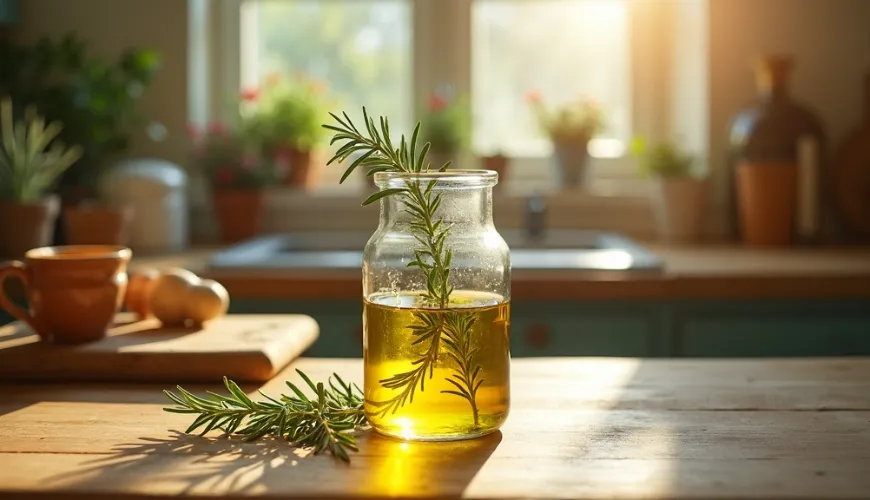
How to Process Rosemary for Health and Homemade Cosmetics

Rosemary is one of those herbs that is easy to fall in love with—it smells of the Mediterranean, tastes of the sun, and has surprisingly versatile uses. It's not just a favorite cooking spice, but also an herb with medicinal properties, useful in homemade cosmetics, teas, and even as a natural repellent. It might already be growing in your garden or in a pot on your balcony. And perhaps you're considering how to preserve rosemary so you can enjoy its fragrance and potency even out of season. So—how best to process rosemary so it doesn't lose its strength and can shine in all its glory?
When and How to Harvest Rosemary
Before we delve into processing, it's worth mentioning when and how to harvest rosemary. It is most potent during its flowering period, usually from June to August, depending on the weather and location. Harvest young, but not completely new, shoots, ideally in the morning when the plant is hydrated from the night but already dry from the dew. Cut the stems with sharp scissors about 10 cm from the top, always leaving enough leaves for continued growth.
Drying, Freezing, or Oil? Ways to Process Rosemary
Rosemary can be processed in many ways, depending on the end goal. Whether you want to preserve its aroma for winter, use its health benefits, or enrich homemade cosmetics, there are plenty of options.
Drying is one of the most common ways to preserve rosemary long-term. It's suitable for those who want to use it as a spice in dishes. It can be dried by hanging in small bundles in a dry, well-ventilated place away from direct sunlight. After a few days, the leaves should easily crumble between your fingers. It is then advisable to separate them from the twigs and store them in an airtight jar.
Unlike drying, which partially alters the taste of rosemary, freezing preserves the fresh taste of the herb almost unchanged. Simply wrap individual sprigs of rosemary in food wrap or wax paper and place them in the freezer. Even more practical is chopping the leaves and freezing them in an ice cube tray with a bit of olive oil or water—ideal portions for cooking that you always have on hand.
A very popular and aesthetic way to preserve rosemary is herbal oil. Simply place several fresh (or pre-dried) sprigs of rosemary into a clean jar with quality olive oil, seal, and let it macerate for a few weeks in a dark place. The result is a flavored oil suitable for salads or as a marinade. Similarly, you can prepare rosemary vinegar, which is great for seasoning vegetables or as part of homemade cleaning products.
The Healing Power of Rosemary - Tea, Tincture, and Bath
Rosemary is not just an aromatic herb but also a potent aid in traditional medicine. In ancient Greece, it was believed that rosemary strengthens memory and concentration. In modern phytotherapy, it is used mainly to support blood circulation, combat fatigue, and aid digestive issues.
One of the simplest ways to use rosemary medicinally is to prepare an infusion—tea. Simply pour a teaspoon of dried or fresh leaves with a cup of boiling water, cover, and let it steep for 5–10 minutes. Rosemary tea invigorates, warms, and stimulates liver activity, and is often drunk in the morning for better concentration.
A stronger form is a tincture, where rosemary is steeped in strong alcohol. Place fresh or dried leaves in a jar, cover with brandy or vodka, and let macerate for at least 3 weeks. Then strain and store in the dark. Tincture is taken by drops—for example, during fatigue or to support digestion.
The beneficial effect of rosemary on the musculoskeletal system is also utilized in external use—such as in baths or compresses. Add a strong rosemary decoction to the bath or prepare a compress for tired muscles.
Homemade Cosmetics and Rosemary - More Than Just a Fragrance
Rosemary is a popular ingredient in natural cosmetics—not only for its antibacterial and anti-inflammatory properties but also as a stimulant for hair roots. Rosemary infusion or hydrosol is added to hair waters, shampoos, and facial tonics.
Making rosemary hair water at home is surprisingly simple. Just boil a handful of rosemary sprigs in water for about 10 minutes, let it cool, strain, and store in the refrigerator. Daily scalp massage with this infusion can promote hair growth and reduce hair loss.
Similarly, you can prepare a facial tonic that refreshes oily or problematic skin. Thanks to its astringent effect, it tightens pores, reduces shine, and soothes inflamed areas. If you have rosemary essential oil, just add a few drops to floral water or a plant oil—such as jojoba.
Kitchen Inspiration - Where Rosemary Shines
In the kitchen, rosemary has countless uses. Its distinct, resinous flavor pairs well with roasted meats, potatoes, legumes, and even bread. A classic example is rosemary focaccia, where fresh leaves and sea salt are incorporated, or roasted potatoes with garlic and a sprig of rosemary.
Less known but all the more interesting is the use of rosemary in desserts. For example, rosemary syrup added to lemonade or sorbet provides a mildly herbal tone that surprises with its freshness. To prepare it, simply boil water with sugar and a few sprigs of fresh rosemary, let it cool, and strain.
In Italy, rosemary is called "rosmarino"—literally "sea dew." A name that captures its origin and character. Not only does it grow in rocky soils near the sea, but every touch indeed resembles a sparkling drop of dew carrying the scent of summer.
Practical Experience - A Small Garden, Big Benefit
A blog reader, Mrs. Alena from Kroměříž, shared her experience: "I've been growing rosemary for five years, and even though I have to move it indoors in winter, it's worth it. I dry it on a hanger in the kitchen, and for Christmas, I make rosemary soap bars as gifts. My grandson says it smells like at grandma's in Italy—and we've never even been there." It's clear that even an ordinary shrub can be a source of joy, fragrance, and health.
Thus, rosemary is more than just a spice—it's a natural treasure that can enliven food, body, and mind. Whether drying, freezing, cooking, or macerating, each method has its place. The important thing is that it makes sense. In times when we're seeking ways back to nature, rosemary is a small but strong step in the right direction.

